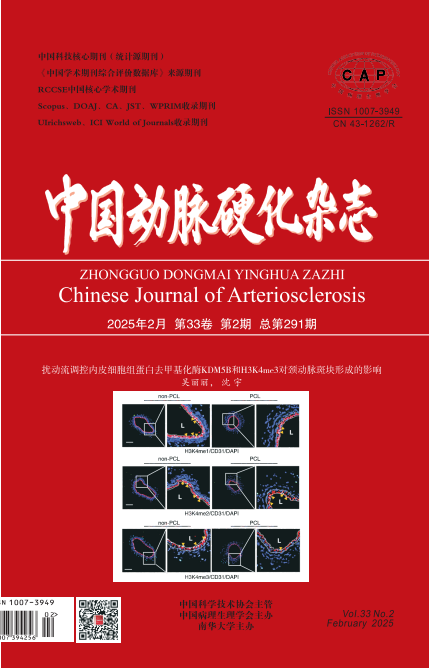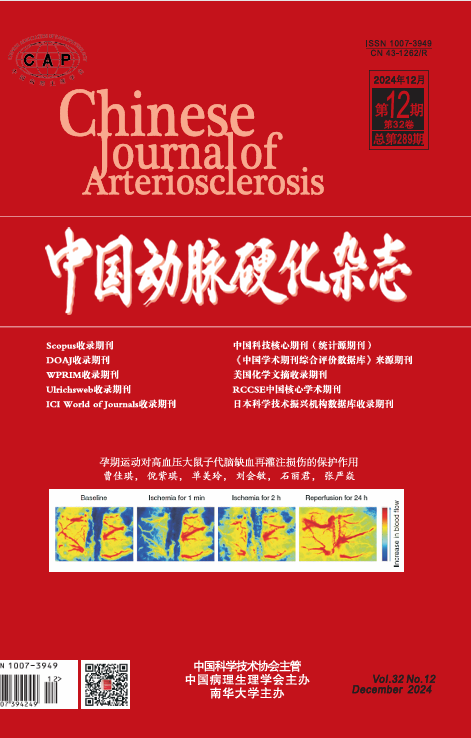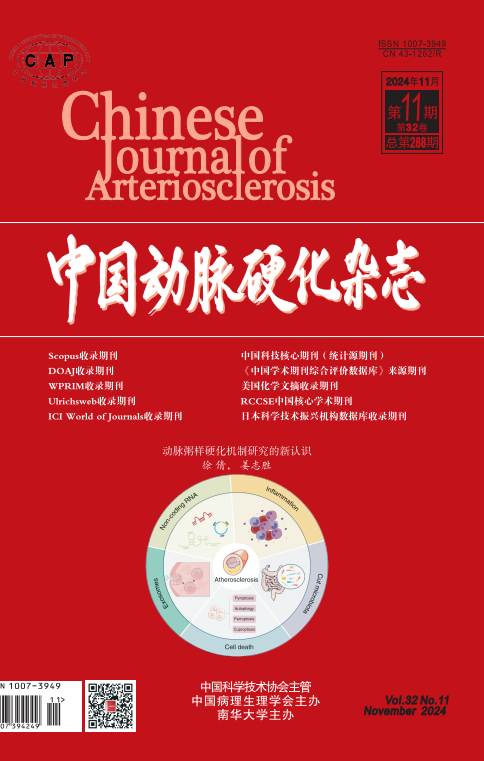 Download Center More+
Download Center More+
 Information
Information
Governing Body China Association for Science and Technology
Sponsors Chinese Association of Pathophysiology; University of South China
Editing and Publishing Editorial Office of Chinese Journal of Arteriosclerosis
Post Issuing Code 42-165
Domestic Distribution Hunan Provincial Newspaper and Periodical Distribution Bureau of China Post Group Corporation
Foreign Distribution China International Book Trading Corporation
Chinese Journal of Arteriosclerosis (CN 43-1262/R, ISSN 1007-3949) is a professional academic journal governed by China Association for Science and Technology and sponsored by Chinese Association of Pathophysiology and University of South China. The publishing scope of the journal includes the prevention and treatment of arteriosclerotic diseases (such as hyperlipidemia, coronary artery disease, ischemic cerebrovascular disease, hypertension, arteriosclerosis and other ischemic diseases) in traditional Chinese medicine, preventive medicine, basic medicine, clinical medicine, pharmacology and special medicine. The columns include original research article (including epidemiological research, experimental research, clinical research and methodological research), review, diagnosis and treatment experience, case report, lectures, etc.
See the fullprofile>
-
The progress of RNA splicing and splicing factors in the atherogenesis
2025, DOI: 10. 20039/ j. cnki. 1007-3949. 2025. 02. 001
Abstract:
RNA splicing is an important process for eukaryotes to regulate gene expression. Alternative splicing allows organisms to produce multiple functional RNAs and proteins from a single transcript, thereby expanding the application of genetic information. Moreover, alternative splicing makes it a reality that limited numbers genes can express numerous complex proteins. More and more studies reveal that incorrect splicing is closely associated with human diseases including cardiovascular diseases. This review provides an overview of the definition and mechanism of RNA splicing, as well as the role of alternative splicing in the pathogenesis of atherosclerosis.
-
Advance in biomechanical factors regulating angiogenesis in atherosclerotic plaques
PENG Chengxiu, CHEN Hanxiao, ZENG Yuhan, FENG Yujing, LI Yuhao, SHEN Yang
2025, DOI: 10. 20039/ j. cnki. 1007-3949. 2025. 02. 002
Abstract:
Angiogenesis within atherosclerotic plaques is a critical determinant of plaque stability. The biomechanical microenvironment, consisting of fluid shear force, plaque structural stress, and matrix stiffness, serves as significant factors in mediating plaque angiogenesis. Endothelial cells respond to mechanical signals and participate in plaques neovascularization through force chemical signal transduction mechanisms. This review provides an overview of the mechanisms by which mechanical factors regulate angiogenesis within plaques and offers a novel therapeutic approach for the prevention and treatment of atherosclerosis.
-
Lycopene activates the LXR/PI3K/Akt pathway to mediate mitochondrial activity affecting myocardial microvascular remodeling
LUO Ting, LI Zhan, LI Shan, ZHOU Jianhua, HUANG Yan, FU Fengbo
2025, DOI: 10. 20039/ j. cnki. 1007-3949. 2025. 02. 003
Abstract:
Aim To investigate the effects of lycopene on myocardial microvascular remodeling and elucidate its underlying mechanisms via the LXR/PI3K/Akt pathway. Methods 50 SD rats were selected to establish a coronary microcirculation disorder model and divided into sham, model and low/mid/high concentration lycopene groups. Left ventricular end-diastolic diameter (LVEDD), left ventricular end-systolic diameter (LVESD), left ventricular ejection fraction (LVEF) and left ventricular fractional shortening (LVFS) in rats were detected using echocardiography, creatine kinase (CK), lactate dehydrogenase (LDH), vascular endothelial growth factor (VEGF), platelet-derived growth factor (PDGF) were detected using ELISA, matrix metalloproteinase-9 (MMP-9), matrix metalloproteinase-2 (MMP-2) and PI3K/Akt pathway related protein expression were detected using Western blot, and liver X receptor α (LXRα) and liver X receptor β (LXRβ) expression were detected using immunohistochemical staining. In vitro, a hypoxia model of myocardial microvascular endothelial cells (MCMEC) was established, with groups including control, hypoxia, hypoxia+low/mid/high concentration lycopene, LXR/PI3K/Akt pathway inhibitor group and mitochondrial fission inhibitor group. Cell viability was detected using CCK-8, LXRα and LXRβ were detected using immunofluorescence, superoxide dismutase (SOD), reactive oxygen species (ROS), VEGF and PDGF levels were detected using ELISA, mitochondrial function-related proteins (Drp1, Fis1, LC3-II/LC3-I, PINK1, Parkin and Opa1) and MMP-9, MMP-2 and PI3K/Akt pathway related proteins were detected using Western blot, and myocardial tissue injury was evaluated using HE staining. Results Compared with the sham group, the model group exhibited severe myocardial injury, with increased levels of LVEDD, LVESD, CK and LDH, decreased LVEF and LVFS, downregulated expression of VEGF, PDGF, MMP-9 and MMP-2, decreased expression of p-PI3K/PI3K and p-Akt/Akt, and downregulated expression of LXRα and LXRβ. In cells, compared with the control group, the hypoxia group showed decreased cell viability, downregulated expression of VEGF, PDGF, MMP-9, and MMP-2, and decreased expression of p-PI3K/PI3K and p-Akt/Akt. Lycopene treatment could effectively reverse the above changes and increase the expression of LXRα and LXRβ. Moreover, lycopene could also reverse and modulate the characteristic alterations of Drp1, Fis1, LC3-II/LC3-I, PINK1, Parkin and Opa1 induced by LXR/PI3K/Akt pathway inhibitors or mitochondrial fission inhibitors. Conclusion Lycopene enhances mitochondrial activity, reduces oxidative stress and improves myocardial microvascular remodeling by activating the LXR/PI3K/Akt pathway.
-
The effect of disturbed flow regulation on endothelial histone demethylase KDM5B and H3K4me3 on carotid plaque formation
2025, DOI: 10. 20039/ j. cnki. 1007-3949. 2025. 02. 004
Abstract:
Aim To investigate whether disturbed flow affects endothelial cell function and atherosclerotic plaque formation by regulating histone demethylase KDM5B and epigenetic modification. Methods After partial carotid artery ligation (PCL), single-cell data analysis and immunofluorescence staining were used to investigate the changes of histone methylation level and histone demethylase expression in carotid endothelial cells of wild type mice under perturbed flow. qPCR and Western blot were used to detect the expression of KDM5B and H3K4me3 in endothelial cells exposed to disturbed flow. Transcriptome sequencing was used to analyze the effect of KDM5B knockdown on endothelial cell function.Endothelial cell ring formation assay was used to verify the effect of KDM5B on angiogenesis. PCL combined with high-fat diet for 2 weeks was used to establish a carotid artery plaque model to analyze the effect of KDM5B knockdown on plaque formation. Results There was a large amount of H3K4me3 methylation in vascular endothelial cells. Blood disturbed flow reduced the methylation of H3K4me3 (P<0.01) and promoted the expression of histone demethylases KDM5B in endothelial cells (P<0.05). Compared with control group, inhibition of KDM5B activity or knockdown of KDM5B increased H3K4me3 level in endothelial cells (P<0.05). Compared with Con313 control group, KDM5B knockdown reduced atherosclerotic plaque formation by 41.45% (Con313 control group:42.17%±1.90%, shKDM5B knockdown group:24.69%±1.60%, P<0.01) by inhibiting angiogenesis. Conclusions Blood disturbed flow promotes KDM5B expression, reduces H3K4me3 modification, and promotes angiogenesis and atherosclerotic plaque formation. Targeting the KDM5B-H3K4me3 axis can be used as a candidate therapeutic target related to cardiovascular diseases.
-
Construction and evaluation of a predictive model for the occurrence of major adverse cardiovascular events in patients with coronary heart disease combined with type 2 diabetes mellitus based on a prognostic nutritional index
CHEN Kun, AN Hui, QI Peng, CHEN Shuxia, GU Jian
2025, DOI: 10. 20039/ j. cnki. 1007-3949. 2025. 02. 005
Abstract:
Aim To investigate the related influencing factors of major adverse cardiovascular events (MACE) in coronary heart disease (CHD) patients with type 2 diabetes mellitus (T2DM) based on prognostic nutritional index (PNI), and to construct a prediction model. Methods The clinical data of 391 patients with CHD combined with T2DM who were hospitalised in the Department of Cardiovascular Medicine of Hebei Provincial People's Hospital from January 2022 to January 2023 were collected and followed up for 1 year, and were divided into the MACE group (n=99) and the non-MACE group (n=292) according to the presence or absence of the occurrence of MACE, and were divided into the training set (n=273) and the validation set (n=118) in a ratio of 7∶3 by using the computer-generated random number method, and the patients in the training set were divided into the MACE (n=67) group and the non-MACE group (n=206) according to whether they had MACE or not. Lasso regression was used to screen the relevant influencing factors and to construct the prediction model of the column-line diagram, and the prediction model was validated by plotting receiver operating characteristic (ROC) curve, calibration curve, decision curve analysis (DCA), and clinical impact curve (CIC). Results Lasso regression showed that the use of angiotensin receptor neprilysin inhibitor (ARNI), fasting blood glucose (FBG), C-reactive protein (CRP), platelet to lymphocyte ratio (PLR), lipoprotein(a) (Lp(a), and PNI were the predictors of the occurrence of MACE in patients with CHD combined with T2DM. A column-line graph prediction model was constructed and validated based on the above predictors, and the area under the ROC curve (AUC) was 0.838(95%CI:0.778~0.898) in the training set and 0.872(95%CI:0.803~0.942) in the validation set, with a good discriminatory degree of the model, and the C-values of the calibration curves in the training set and the validation set were 0.838 and 0.872, respectively, with good fit. The results of the decision curve analysis and the clinical impact curve showed that the column-line graph prediction model had a higher net yield of MACE in patients with CHD combined with T2DM, with high clinical utility. Conclusion PNI is an influential factor in the occurrence of MACE in patients with CHD combined with T2DM, and the column-line graphical model constructed on the basis of predictors such as PNI is convenient for clinical use and has high predictive value in predicting the occurrence of MACE in patients with CHD combined with T2DM.
-
Correlation between N6-methyladenosine and ferroptosis in acute myocardial infarction
ZHANG Tingting, AN Lijuan, AZIGULI·Gulamujiang, ZAIMIRAN·Nuerta, ZHANG Yaling, LIU Gang, LUO Mei
2025, DOI: 10. 20039/ j. cnki. 1007-3949. 2025. 02. 006
Abstract:
Aim To analyze the correlation between N6-methyladenosine (m6A) and ferroptosis in acute myocardial infarction (AMI). Methods Two microarray datasets GSE34198 and GSE59867 was explored from GEO database. Both AMI and control samples were analyzed for differentially expressed genes. GO, KEGG, and GSVA analysis of the screened differential genes was performed using R. Machine learning was used to screen ferroptosis associated genes for DRA, GBM, LASSO and randomForest characteristic genes. The expression data of the core ferroptosis gene and m6A-related genes were analyzed by Pearson correlation analysis, and the m6A modified genes and ferroptosis associated genes with strong correlation were screened. Finally, 10 cases of AMI and 10 control whole blood samples from the Fifth Affiliated Hospital of Xinjiang Medical University were collected, and the expression of related genes was verified by RT-qPCR and Western blot. Results 431 common differentially expressed genes were extracted from two datasets, GO and KEGG analysis showed that these genes were mainly enriched in TNF signaling pathway, FoxO signaling pathway and B cell receptor signaling pathway. The enrichment pathways of differentially expressed genes by GSVA were cuproptosis, netotic cell death, entotic cell death, alkaliptosis and ferroptosis. The characteristic genes of ferroptosis associated genes were screened by machine learning, and 19 core ferroptosis associated genes were screened from them. The expression data of ferroptosis associated genes and m6A-related genes were analyzed by Pearson correlation analysis. LRPPRC-IREB2, LRPPRC-ATG5, YTHDC2-IREB2, HNRNPA2B1-IREB2 and YTHDC2-ATG5 were the most correlated top five genes. The results of RT-qPCR and Western blot showed that the gene expression levels of LRPPRC, YTHDC2, HNRNPA2B1, IREB2 and ATG5 were significantly lower than those of the control group (P<0.001), which was consistent with the gene expression in the database. Conclusion m6A methylation is associated with ferroptosis in AMI. By regulating m6A methylation-related genes, ferroptosis in AMI can be regulated. It provides a new idea for the further study of the pathogenesis of the disease.
-
Evaluation of right atrial function by 2D-STI combined with RE-3DE in patients with triple vessel coronary artery disease without myocardial infarction
ZHANG Siran, LI Xiya, WANG Yifan, MA Le, LI Guangsen
2025, DOI: 10. 20039/ j. cnki. 1007-3949. 2025. 02. 007
Abstract:
Aim To evaluate the right atrial function by two-dimensional speckle tracking imaging (2D-STI) combined with real-time three-dimensional echocardiography (RT-3DE) in patients with triple vessel coronary artery disease (TVCAD) without myocardial infarction. Methods Fifty-six patients with TVCAD without myocardial infarction were selected and divided into two groups according to the results of coronary angiography:28 cases with a stenosis rate of 50%~75% and 28 cases with a stenosis rate of ≥75%. In addition, 30 healthy volunteers were screened as control group. RT-3DE was performed to obtain the parameters of right atrial volume (RAVmax, RAVmin and RAVp) and then calculated right atrial passive ejection fraction (RAPEF) and right atrial active ejection fraction (RAAEF), and the maximum of right atrial volume index (RAVImax). 2D-STI was applied to measure right atrium strain rates during systole, early diastole and late diastole (RASRs, RASRe and RASRa). Correlation between 2D-STI parameters and N-terminal pro-brain natriuretic peptide (NT-proBNP), Gensini scores were analyzed by Pearson analysis. ROC curve analysis was used to evaluate the diagnostic value of 2D-STI, RT-3DE, and their combined use for right atrial function in TVCAD patients without myocardial infarction. Results Compared with control group, RAPEF and RASRe reduced in stenosis rate of 50%~75% group, while RAAEF and RASRa increased (all P<0.05). Compared with control group and stenosis rate of 50%~75% group, RAPEF, RASRs, RASRe and RASRa decreased, while RAVmax, RAVmin, RAVp, RAVImax and RAAEF increased in stenosis rate of ≥75% group (all P<0.05). There was a significant correlation between 2D-STI parameters and NT-proBNP and Gensini scores. The area under the curve of right atrial function in TVCAD patients without myocardial infarction was 0.8,0.8917 and 0.9564 for 2D-STI, RT-3DE and their combined use, respectively. The diagnostic efficacy of the two methods was significantly higher when used in combination than when used alone, and 2D-STI was superior to RT-3DE. Conclusion When evaluating the right atrial function of TVCAD patients without myocardial infarction, the diagnostic efficacy of 2D-STI combined with RT-3DE is higher than that of using it alone, and 2D-STI is superior to RT-3DE.
-
Application of cardiac magnetic resonance T1 mapping in cardiomyopathy and development of imaging technology
DENG Jia, TANG Huifang, ZHOU Hong, YU Ying, YANG Wenmin, ZHOU Jinbiao, TIAN Jinwei
2025, DOI: 10. 20039/ j. cnki. 1007-3949. 2025. 02. 009
Abstract:
As cardiac magnetic resonance imaging technology advances, T1 mapping has emerged as a non-invasive method offering visual and quantitative insights into myocardial fibrosis, edema, and infiltration associated with cardiac diseases. The application of T1 mapping in myocardial diseases allows for evaluating both focal and diffuse myocardial fibrosis, playing a crucial clinical role in the differentiation, treatment, and prognostic risk assessment of diseases. This article aims to provide a thorough overview of the clinical applications of T1 mapping in patients with cardiomyopathy, summarizing the commonly employed scanning techniques and imaging principles.
-
Research progress on vascular inflammation in the pathogenesis of aortic dissection
LI Yanjie, XIANG Ziping, LIU Xin, ZHANG Mingming
2025, DOI: 10. 20039/ j. cnki. 1007-3949. 2025. 02. 010
Abstract:
At present, with the development of new diagnostic technologies, the detection rate of aortic dissection has been increasing year by year, but its mortality rate still remains high. Cardiovascular disease is a chronic inflammatory disease, and vascular inflammation plays a major role in the progression of aortic dissection. Therefore, this article systematically describes the specific roles and mechanisms of inflammatory cells, inflammatory factors, and inflammasomes in the development of aortic dissection.
-
The emerging role of lncRNA-mediated ceRNA regulatory networks in atherosclerosis-associated endothelial dysfunction
LUO Jinwen, LIU Min, LI Min, YU Yanqiao, SHI Dazhuo, MA Xiaojuan
2025, DOI: 10. 20039/ j. cnki. 1007-3949. 2025. 02. 011
Abstract:
Endothelial dysfunction is a pivotal contributor to atherosclerosis (As) pathogenesis. A comprehensive understanding of the mechanisms of endothelial dysfunction would provide novel insights into effective treatment of As. Recent advances in genome and transcripome technology have enabled researchers to further explore the molecular mechanisms of endothelial dysfunction. It has been found that the regulatory network of competitive endogenous RNA (ceRNA) mediated by long non-coding RNA (lncRNA) plays a key role in endothelial dysfunction. lncRNA acts as a “molecular sponge” for microRNA (miRNA) to block the post-transcriptional repression of miRNA on downstream target gene messenger RNA (mRNA) by binding to miRNA, thereby regulating the function and phenotypic conversion of endothelial cell (EC) lncRNA-miRNA-mRNA interactions are widely involved in play an essential role EC inflammatory responses, apoptosis, autophagy, angiogenesis, and endothelial-mesenchymal transition (EndMT). Which suggests that it may be a potential therapeutic targets for As.
-
Research progress of the relationship between phenylacetylglutamine and cardiovascular disease
CHEN Wan, YU Xiaohua, ZOU Jin, WANG Gang
2025, DOI: 10. 20039/ j. cnki. 1007-3949. 2025. 02. 012
Abstract:
Cardiovascular diseases have become the leading cause of mortality worldwide. The gut microbiota and its metabolites play an important role in the occurrence and development of cardiovascular diseases, and an imbalance of gut microbiota and its metabolites can promote the progression of cardiovascular diseases. Phenylacetylglutamine is a phenylalanine metabolite of intestinal flora. More and more studies have shown that phenylacetylglutamine is an independent risk factor of cardiovascular diseases and a potential biomarker of cardiovascular diseases. It is involved in the pathogenesis of cardiovascular diseases, such as arrhythmia, heart failure, atherosclerosis, etc. Therefore, interventions targeting phenylacetylglutamine are expected to become a new strategy for treating cardiovascular diseases. This review focuses on the role of phenylacetylglutamine in the occurrence and development of several common cardiovascular diseases.

 Online Submit
Online Submit Reviewing
Reviewing Edit
Edit Reader
Reader Quick Search
Quick Search External Links
External Links





